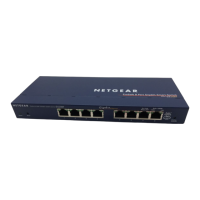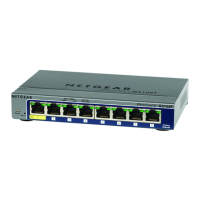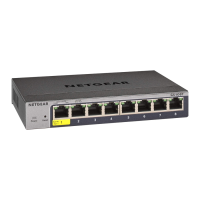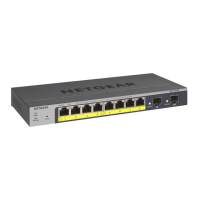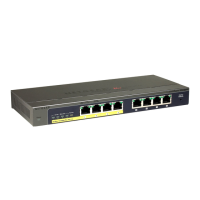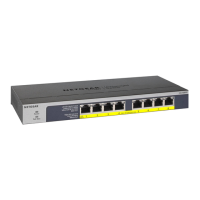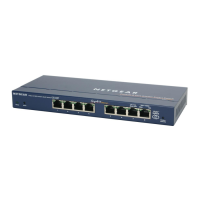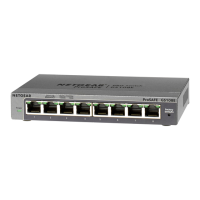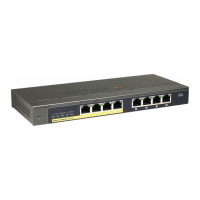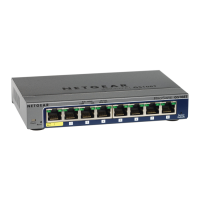
Do you have a question about the NETGEAR GS108T-200NAS and is the answer not in the manual?
| Model | GS108T |
|---|---|
| Category | Switch |
| Ports | 8 |
| Power over Ethernet (PoE) | No |
| Layer | Layer 2 |
| VLAN Support | Yes |
| QoS | Yes |
| Switching Capacity | 16 Gbps |
| Forwarding Rate | 11.9 Mpps |
| Jumbo Frame Support | Yes |
| LACP Support | Yes |
| MAC Address Table Size | 8K |
| Operating Temperature | 0° to 40°C (32° to 104°F) |
| Storage Temperature | -20 to 70 °C |
| Humidity | 90% non-condensing |
| Warranty | Limited Lifetime |
| Type | Smart Managed Switch |
| Management | Web Managed (Smart) |
Describes typographical conventions, formats, and scope of the manual.
Provides instructions on how to print the manual using Adobe Acrobat Reader.
Overview of the Web-based management interface for switch configuration.
Steps to connect the switch to a network for remote management.
Procedure to discover switches using Smart Control Center with DHCP.
Procedure to discover switches and assign static IP without DHCP.
How to access the switch's management interface via a web browser.
Overview of utilities for switch discovery, management, and upgrades.
Procedure for upgrading the switch's firmware using TFTP protocol.
Configures basic system information like IP address, clock, and DNS.
Configures network settings for the switch management interface.
Configures the system's date and time using SNTP or manual settings.
Configures Simple Network Management Protocol settings for monitoring.
Configures Link Layer Discovery Protocol for network topology information.
Configures DHCP filtering to prevent unauthorized DHCP servers.
Manages and monitors physical port information and settings.
Configures physical interface settings for ports and LAGs.
Configures port channels to combine multiple links for fault tolerance.
Configures Virtual Local Area Networks for network segmentation.
Defines VLAN groups and membership within the VLAN table.
Configures settings for ports carrying IP phone traffic for quality.
Configures Spanning Tree Protocol to prevent network loops.
Enables and configures Spanning Tree Protocol operation on the switch.
Configures IGMP snooping for intelligent multicast traffic forwarding.
Configures CoS queueing features for network traffic prioritization.
Sets the trust mode for interfaces to classify traffic based on priority.
Defines queue bandwidth, depth, and transmission scheduling per port.
Supports DiffServ for classifying traffic and applying QoS treatment.
Associates classes with policy statements for QoS traffic handling.
Configures login password, RADIUS, TACACS+, and authentication lists.
Allows changing the login password for the management interface.
Configures RADIUS servers for centralized user authentication.
Enables and configures port access control using 802.1X.
Enables or disables port access control on the system.
Configures MAC filters, Storm Control, Port Security, and Protected Ports.
Configures port security to lock ports and limit MAC addresses.
Sets up ACLs to control access and filter network traffic.
Creates MAC ACLs to filter traffic based on MAC addresses.
Creates IP ACLs to filter traffic based on IP addresses and protocols.
Provides traffic information for transmitted and received data.
Displays detailed statistical information about the traffic handled by the switch.
Summarizes per-port traffic statistics on the switch.
Manages system messages for events, faults, and errors.
Configures port mirroring for network traffic analysis.
Provides options for rebooting or restoring factory default settings.
Reboots the GS108T or GS110TP switch.
Resets the system configuration to the factory default values.
Downloads system files (software, config) from a remote system.
Provides tools for diagnosing network connectivity and performance issues.
Tests network connectivity to a specified IP address or hostname.
Provides access to online resources for assistance with the switch.
Details hardware features, protocols, and performance metrics of the switches.
Explains VLAN concepts and provides configuration examples.
Demonstrates VLAN usage scenarios and traffic handling.
Explains ACL concepts and provides configuration guidelines.
Shows how to create a MAC-based ACL to permit/deny traffic.
Explains 802.1X port-based access control and provides examples.
Demonstrates configuring 802.1X for port authentication.
Explains Multiple Spanning Tree Protocol and provides configuration examples.
Demonstrates creating MSTP instances for network topology.
